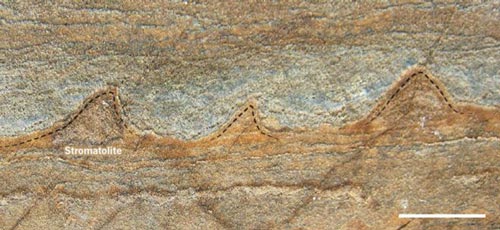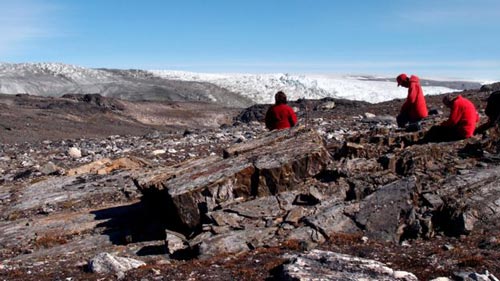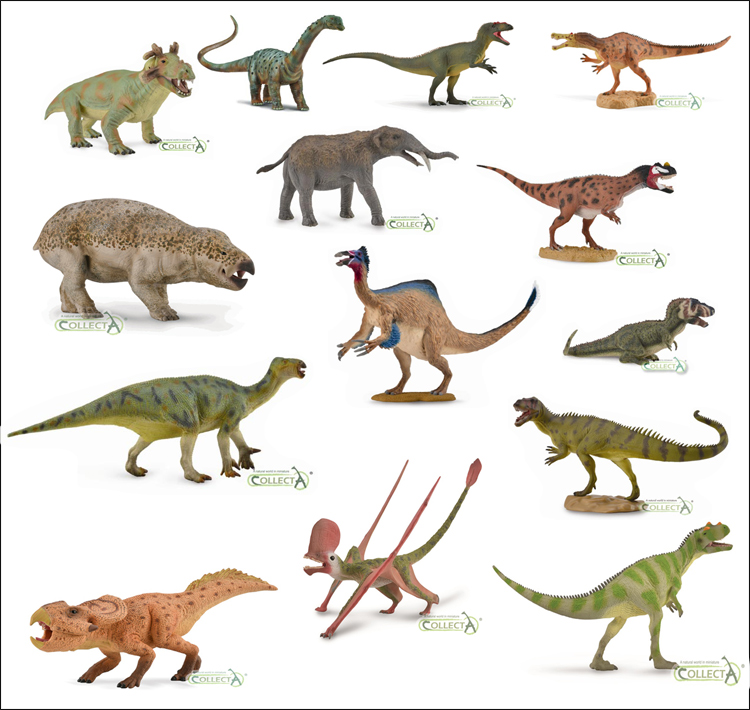3.7-Billion-Year-Old Microbial Structures? A Fascinating Question
A Rapid Emergence of Life on Earth?
When did life on Earth begin? That is a very difficult question to answer, however, a team of scientists have published in the journal “Nature” this week suggesting that stromatolites (microbial colonies) existed in shallow marine environments as early as 3.7 billion years ago. It’s all to do with waves and squiggles preserved in sedimentary strata from south-western Greenland.
Stromatolite Microbial Structures
Do These Wavy Lines and Structures Preserved in Ancient Sedimentary Rocks Indicate the Presence of Colonial Bacteria?
Picture credit: University of Wollongong
In the picture above the white scale bar represents 4 centimetres.
Although the paper is not without its controversy, if these waves and squiggles do turn out to be the ancient signatures left by mats of bacteria, then they would predate the previously oldest known fossils (from Australia) by some 200 million years or more. Such claims are hotly contested, about as hot as the young Earth when the researchers (from a number of Australian institutions as well as from the UK), claim these stromatolites first existed.
The Isua Supercrustal Belt
The bleak, desolate uplands of south-western Greenland hold a secret. The rocks here are the oldest surviving piece of the Earth’s surface. As our planet continues to warm, so ice sheets shrink and slowly and surely, like the advance of geological time itself, new parts of our planet’s ancient crust are exposed.
This geological feature is called the Isua Supercrustal Belt (ISB). Professor Martin van Kranendonk (University of New South Wales), specialises in the study of ancient life forms, dedicating his career to examining rocks for traces of Archean and Proterozoic life. He and his colleagues hypothesise that the waves and cones seen in the ancient Greenland rocks are the traces of stromatolite stacks.
Researchers Exploring the ISB of Greenland
Picture credit: Picasa
Ancient Rocks and Ancient Fossils
Professor Kranendonk commented:
“We see the original unaltered sedimentary layers, and we can see how the stromatolite structures grow up through the sedimentary layering. And we can see the characteristic dome and cone-shaped forms of modern stromatolites.”
If this is evidence of microbial colonies preserved in rocks some 3,700 million years old, then they predate by some 220 million years the previous most convincing and generally accepted evidence for the oldest life on Earth, the stromatolite fossils from the 3,480 million year old Dresser Formation of the Pilbara Craton, Australia. These ancient rocks located in Western Australia are mostly volcanic in origin but the strata also preserves evidence of hydrothermal locations (hot springs), indicated by the presence of large quantities of the mineral barite.
These areas are associated with wrinkled structures, columns and cone shaped rocks, interpreted as evidence of stromatolite structures having existed within the hot springs and surrounding areas.
Ancient Stromatolites
The ISB fossil material indicates the establishment of shallow marine carbonate production with biotic CO2 sequestration by 3,700 million years ago, close to the start of our planet’s sedimentary record. If this is the case, then genetic molecular clock studies would push back the origin of life to before the Archaen Eon and into the Hadean Eon.
The Hadean Eon is the very oldest part of the Earth’s geological record. It covers the period from our planet’s formation some 4.57 billion years ago to around 4 billion years ago (the start of the Archean Eon). This suggests that life began on our planet when it was still being bombarded by extraterrestrial bodies, remnants from the formation of our solar system (the “Great Cometary Bombardment”).
For models and replicas of ancient prehistoric creatures: Wild Safari Prehistoric World Models.
Shark Bay Western Australia
Stromatolites can still be found today in various parts of the world (freshwater and marine environments). For example, they can still be seen around the coast of Western Australia in a very saline body of water called Shark Bay. The mushroom shaped structures found on the floor of the bay are the work of cyanobacterial communities. Layers of mineral grains are glued together by the sticky, colonial bacteria.
To read an article from Everything Dinosaur published in 2010 about fossil evidence for the earliest animals found: Sponge-like Fossils May Be Earliest Animals.




